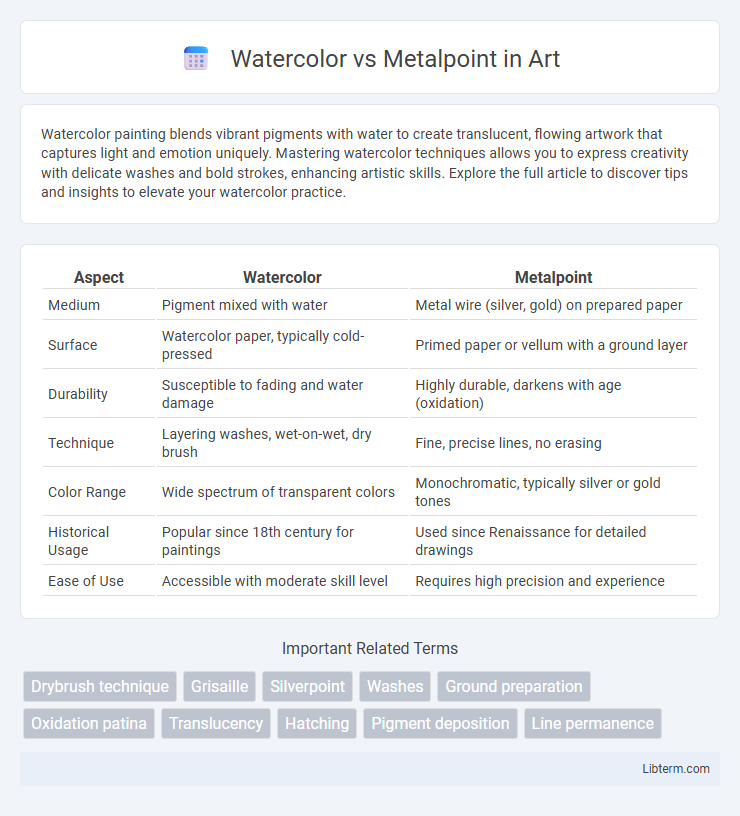Watercolor painting blends vibrant pigments with water to create translucent, flowing artwork that captures light and emotion uniquely. Mastering watercolor techniques allows you to express creativity with delicate washes and bold strokes, enhancing artistic skills. Explore the full article to discover tips and insights to elevate your watercolor practice.
Table of Comparison
| Aspect | Watercolor | Metalpoint |
|---|---|---|
| Medium | Pigment mixed with water | Metal wire (silver, gold) on prepared paper |
| Surface | Watercolor paper, typically cold-pressed | Primed paper or vellum with a ground layer |
| Durability | Susceptible to fading and water damage | Highly durable, darkens with age (oxidation) |
| Technique | Layering washes, wet-on-wet, dry brush | Fine, precise lines, no erasing |
| Color Range | Wide spectrum of transparent colors | Monochromatic, typically silver or gold tones |
| Historical Usage | Popular since 18th century for paintings | Used since Renaissance for detailed drawings |
| Ease of Use | Accessible with moderate skill level | Requires high precision and experience |
Introduction to Watercolor and Metalpoint
Watercolor is a transparent painting medium that uses pigments suspended in a water-based solution, allowing artists to create luminous effects with varied washes and layering techniques. Metalpoint involves drawing with a metal stylus, typically silver or gold, on a specially prepared surface, producing delicate, fine lines that develop a unique patina over time. Both mediums require mastery of subtle control and carry distinctive historical significance in traditional and contemporary art practices.
Historical Overview of Both Techniques
Watercolor painting, dating back to ancient Egypt and flourishing during the Renaissance, utilizes pigment suspended in water to create translucent washes, favored for its portability and versatility. Metalpoint, popular in the Middle Ages and Renaissance, employs a thin metal stylus (commonly silver) on prepared surfaces, valued for its fine, precise lines and permanence. Both techniques significantly influenced art history, with watercolor enabling vibrant, fluid compositions and metalpoint emphasizing meticulous detail and draftsmanship.
Core Materials and Tools Used
Watercolor painting uses pigments suspended in a water-based solution applied with brushes on paper designed for absorption and texture. Metalpoint involves drawing with a metal stylus, typically silver, on a specially prepared ground, often coated with a gesso or primer to create a surface that captures fine lines. The core materials for watercolor emphasize fluidity and transparency, while metalpoint relies on the reactive interaction between metal and ground for subtle, precise marks.
Distinctive Artistic Styles Achieved
Watercolor offers fluid transparency with vibrant color gradients, allowing artists to create soft washes and dynamic light effects that enhance naturalistic and impressionistic styles. Metalpoint, characterized by its fine, precise lines and muted tonal range, excels in detailed, delicate renderings often associated with classical and Renaissance art techniques. The choice between watercolor and metalpoint fundamentally influences the artwork's textural depth, emotional tone, and visual impact.
Surface Requirements and Preparation
Watercolor requires a smooth, absorbent surface such as cold-pressed or hot-pressed watercolor paper that can handle wet media while preserving pigment vibrancy and flow. Metalpoint demands a rigid, non-absorbent ground, often prepared with a smooth coating of gesso, bone ash, or chalk mixed with a binder to create a slightly abrasive texture that allows the metal to leave precise marks. Proper preparation of the surface for metalpoint is crucial to prevent smudging and maintain detailed line work, whereas watercolor paper preparation focuses on controlling water retention and pigment spreading.
Durability and Longevity of Artworks
Metalpoint artworks exhibit exceptional durability due to their reliance on metal particles embedded in a prepared surface, resisting fading and environmental damage over centuries. Watercolor paintings, while vibrant and fluid, are more susceptible to light exposure, humidity, and paper degradation, which can compromise their longevity without proper conservation. Museums and collectors often prioritize metalpoint for its archival stability and minimal color alteration over time compared to watercolor's vulnerability to fading and staining.
Techniques for Building Layers and Depth
Watercolor achieves depth through transparent washes and glazing techniques, allowing light to pass through multiple layers of pigment and create luminous effects. Metalpoint employs fine, controlled lines and subtle shading built up gradually, with oxidation of the metal adding natural tonal variations over time. Mastery of layering in watercolor depends on drying times and pigment dilution, while metalpoint requires precision and patience to develop texture and shadow through repeated strokes.
Color Application: Limitations and Possibilities
Watercolor offers vibrant, translucent hues with versatile layering that enables gradient effects and subtle color shifts, but it can be unpredictable when overapplied, leading to pooling or fading. Metalpoint, by contrast, provides precise, fine lines with a limited color palette typically restricted to silver, gold, or copper tones, relying on oxidation over time to develop subtle color changes. While watercolor excels in expressive, fluid color application, metalpoint's rigidity limits saturation but allows for intricate detail and permanence.
Suitability for Beginners and Professionals
Watercolor offers flexible techniques and quick drying times, making it highly suitable for beginners who benefit from easy layering and blending, while professionals appreciate its versatility and rich color palette for detailed, expressive works. Metalpoint requires more precision and patience due to its permanent, delicate lines created by metal styluses on specially prepared surfaces, posing a steeper learning curve that challenges both novices and experienced artists seeking fine, archival-quality drawings. The decision between watercolor and metalpoint depends on the artist's skill level, desired effect, and willingness to engage with the distinctive demands of each medium.
Choosing Between Watercolor and Metalpoint
Choosing between watercolor and metalpoint depends on desired texture and detail; watercolor offers vibrant color blending and fluidity, while metalpoint delivers precise, fine lines with subtle tonal variations. Artists seeking spontaneity and ease of use often prefer watercolor, whereas those valuing archival permanence and delicate line work may opt for metalpoint. Consider project goals, surface preparation, and medium behavior to determine the most suitable technique.
Watercolor Infographic

 libterm.com
libterm.com